We've had a bit of a nightmare with getting a floor that is suitable for a level finish (carpet tiles in our case) which has dragged on since August.
Our extension, internal dimensions 9.7m by 5.1m, has a block and beam construction. The room is going to hold a full size snooker table at one end, and a lounge area at the other, so the floor beams were specified to take the weight accordingly, but that meant the floor had high spots and low spots between the beams.
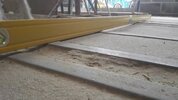
We were advised that due to the difference in height, that a traditional dry screed would be most suitable. First, 100mm foil-backed insulation was put down and fully taped, then ufh pipes were added in 4 loops to minimise the total length of each zone and to minimise the possibility of cold areas when the ufh would be on, and in August we had a local plasterer come to put down the dry screed. Took him two days. The first day was dry, the second day (when a 2nd delivery of dry screed was delivered) it was pouring down all day. The join between the two sections was noticeable, and a small gap appeared between the sections.
All this is important, which is why I've included so much history.
Anyway, this first guy worked so hard (and the labourer he had with him was struggling to bring barrows of the dry screed around to the extension), and we left the stuff to dry out as much as possible but it was really uneven. I mean, at places the difference was maybe 20mm. It's impossible to know how much of a variation there was due to it being so wonky, and a large space.
The original idea for flooring was engineered composite tongue and groove 'wood effect' laminate but it was too expensive considering we'd now need to get someone else in to level the surface before being able to install the laminate.
Anyway, after leaving the screed the full 100 days to dry out, plus extra, a new guy finally came last week to apply the self levelling compound. He used Ardex Arditex NA compound. It's a lot more level now, but there have been a few spots that sunk down at the join where the first guy stopped at the end of day 1.
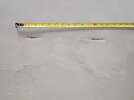
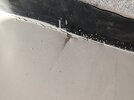
The surface is also full of bumps and little pits. Almost like air bubbles and poorly mixed powder:
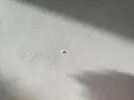
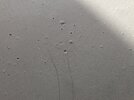
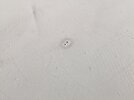
The second guy has said (twice) that he'll come back and apply something to the areas that sunk slightly, but he's been a no-show on both occasions he'd said he would come around, so we're thinking of telling him to not come back and do it ourselves, but I wonder what product would be suitable to fill the sunken areas. They're not big, a few cm or so, and we'll be laying carpet tiles down as our finished floor surface, so it doesn't have to be totally smooth and blended in.
He mentioned also something about a granite block or something that he uses to smooth down any little bumps. Anyone heard of one of those? What could it be?
Looking forward to hearing your recommendations.
Our extension, internal dimensions 9.7m by 5.1m, has a block and beam construction. The room is going to hold a full size snooker table at one end, and a lounge area at the other, so the floor beams were specified to take the weight accordingly, but that meant the floor had high spots and low spots between the beams.

We were advised that due to the difference in height, that a traditional dry screed would be most suitable. First, 100mm foil-backed insulation was put down and fully taped, then ufh pipes were added in 4 loops to minimise the total length of each zone and to minimise the possibility of cold areas when the ufh would be on, and in August we had a local plasterer come to put down the dry screed. Took him two days. The first day was dry, the second day (when a 2nd delivery of dry screed was delivered) it was pouring down all day. The join between the two sections was noticeable, and a small gap appeared between the sections.
All this is important, which is why I've included so much history.
Anyway, this first guy worked so hard (and the labourer he had with him was struggling to bring barrows of the dry screed around to the extension), and we left the stuff to dry out as much as possible but it was really uneven. I mean, at places the difference was maybe 20mm. It's impossible to know how much of a variation there was due to it being so wonky, and a large space.
The original idea for flooring was engineered composite tongue and groove 'wood effect' laminate but it was too expensive considering we'd now need to get someone else in to level the surface before being able to install the laminate.
Anyway, after leaving the screed the full 100 days to dry out, plus extra, a new guy finally came last week to apply the self levelling compound. He used Ardex Arditex NA compound. It's a lot more level now, but there have been a few spots that sunk down at the join where the first guy stopped at the end of day 1.


The surface is also full of bumps and little pits. Almost like air bubbles and poorly mixed powder:



The second guy has said (twice) that he'll come back and apply something to the areas that sunk slightly, but he's been a no-show on both occasions he'd said he would come around, so we're thinking of telling him to not come back and do it ourselves, but I wonder what product would be suitable to fill the sunken areas. They're not big, a few cm or so, and we'll be laying carpet tiles down as our finished floor surface, so it doesn't have to be totally smooth and blended in.
He mentioned also something about a granite block or something that he uses to smooth down any little bumps. Anyone heard of one of those? What could it be?
Looking forward to hearing your recommendations.

